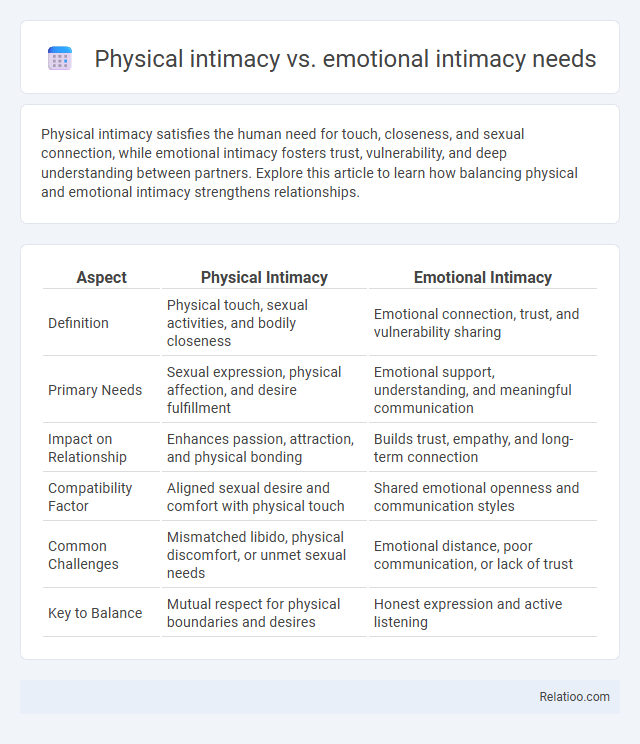Physical intimacy satisfies the human need for touch, closeness, and sexual connection, while emotional intimacy fosters trust, vulnerability, and deep understanding between partners. Explore this article to learn how balancing physical and emotional intimacy strengthens relationships.
Table of Comparison
| Aspect | Physical Intimacy | Emotional Intimacy |
|---|---|---|
| Definition | Physical touch, sexual activities, and bodily closeness | Emotional connection, trust, and vulnerability sharing |
| Primary Needs | Sexual expression, physical affection, and desire fulfillment | Emotional support, understanding, and meaningful communication |
| Impact on Relationship | Enhances passion, attraction, and physical bonding | Builds trust, empathy, and long-term connection |
| Compatibility Factor | Aligned sexual desire and comfort with physical touch | Shared emotional openness and communication styles |
| Common Challenges | Mismatched libido, physical discomfort, or unmet sexual needs | Emotional distance, poor communication, or lack of trust |
| Key to Balance | Mutual respect for physical boundaries and desires | Honest expression and active listening |
Understanding Physical Intimacy Needs
Physical intimacy needs encompass the desire for close touch, affectionate gestures, and sexual connection, which are vital for fostering trust and bonding in relationships. Recognizing and addressing these needs enhances emotional well-being and reinforces relational security, preventing feelings of loneliness and neglect. Unmet physical intimacy needs can lead to frustration, decreased self-esteem, and emotional distancing, highlighting the importance of clear communication and mutual understanding.
Exploring Emotional Intimacy Needs
Exploring emotional intimacy needs reveals the essential desire for deep connection, trust, and understanding beyond physical interactions. Emotional intimacy fosters vulnerability, empathy, and shared experiences that build a strong foundation for meaningful relationships. When these needs remain unmet, Your sense of closeness and emotional security can weaken, leading to feelings of loneliness and dissatisfaction despite physical intimacy.
Key Differences Between Physical and Emotional Intimacy
Physical intimacy involves touch, closeness, and sexual connection, while emotional intimacy centers on trust, vulnerability, and deep communication. Unmet physical needs may lead to feelings of rejection or frustration, whereas unmet emotional intimacy can result in loneliness and emotional disconnection. Understanding these key differences helps partners foster both bodily closeness and psychological bonding for a balanced relationship.
The Role of Communication in Meeting Intimacy Needs
Effective communication plays a crucial role in meeting both physical and emotional intimacy needs by fostering understanding and trust between partners. Open dialogue allows individuals to express their desires and boundaries, reducing the risk of unmet intimacy needs that can lead to emotional distance or dissatisfaction. By prioritizing honest and empathetic conversations, couples can align their expectations and strengthen their emotional and physical connections.
Signs of Imbalance in Physical or Emotional Intimacy
Signs of imbalance in physical intimacy include withdrawal from sexual activities, reduced affection, and discomfort with physical touch, whereas emotional intimacy imbalance manifests through avoidance of deep conversations, lack of trust, and feelings of emotional disconnection. Unmet physical intimacy needs often lead to frustration and decreased relationship satisfaction, while unmet emotional intimacy needs can result in loneliness, anxiety, and increased conflict. Recognizing these signs allows couples to address gaps and restore harmony in both physical and emotional dimensions of their relationship.
The Impact of Intimacy on Relationship Satisfaction
Physical intimacy and emotional intimacy are critical for relationship satisfaction, as they fulfill distinct but interrelated needs; physical closeness fosters connection through touch and affection, while emotional intimacy builds trust and understanding through vulnerability and communication. Unmet needs in either domain often lead to dissatisfaction, with lacking physical intimacy causing feelings of rejection and unmet emotional needs generating loneliness and disconnection. Research indicates that couples who maintain balanced and fulfilling intimacy report higher relationship satisfaction and resilience against conflict.
Addressing Mismatched Intimacy Needs in Couples
Mismatched intimacy needs between physical and emotional desires can create significant tension in relationships, often leading to feelings of frustration or neglect when these needs remain unmet. Understanding and openly communicating your unique emotional and physical intimacy requirements allows couples to bridge gaps and foster deeper connection, enhancing overall relationship satisfaction. Addressing these mismatches through empathy and compromise helps prevent unmet needs from eroding trust and intimacy over time.
Strategies for Nurturing Both Physical and Emotional Intimacy
Cultivating physical and emotional intimacy requires intentional strategies such as open communication, active listening, and expressing appreciation to meet both partners' needs. Prioritizing shared experiences like affectionate touch and meaningful conversations enhances connection and reduces the risk of unmet emotional or physical needs. Consistent efforts in vulnerability and responsiveness foster a balanced intimacy that strengthens relationship satisfaction and resilience.
Overcoming Barriers to Intimacy Fulfillment
Overcoming barriers to intimacy fulfillment requires addressing both physical intimacy needs, such as touch and closeness, and emotional intimacy needs, including trust and vulnerability, to prevent unmet intimacy desires. Effective communication and empathy help partners recognize and validate these needs, fostering deeper connection and reducing feelings of rejection or isolation. Therapeutic interventions like couples counseling can provide tools for navigating past trauma, attachment issues, or misunderstandings that impede intimacy satisfaction.
Building a Healthy Balance Between Physical and Emotional Connection
Balancing physical intimacy and emotional intimacy is essential for a healthy relationship, where each partner's unique needs are acknowledged and met. Unmet emotional or physical needs can lead to frustration, disconnection, and misunderstandings, undermining trust and closeness. You can foster a stronger bond by openly communicating desires, practicing empathy, and prioritizing both physical affection and emotional support for a harmonious connection.

Infographic: Physical intimacy vs Emotional intimacy needs
 relatioo.com
relatioo.com